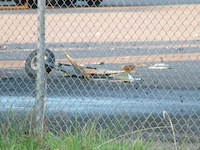By Sharyn L. Decker
Lewis County Sirens news reporter
CHEHALIS – The short flight of the single-engine plane that crashed and burned in Chehalis was rocky from the start, according to the National Transportation Safety Board.
For an unexplained reason, the pilot began his take off on the grass, well back from the approach end of the runway and bounced on the uneven terrain as its speed increased, according to the recently released preliminary report from the NTSB.
“The witness further reported that the airplane subsequently made it onto the runway’s surface and became airborne, but the initial climb was not stabilized; the airplane’s wings were rocking from side to side, and it’s nose was pitching up and down,” the report states.
Within moments, the three-quarter-scale replica of a popular WWII fighter plane, was wrecked and burning in a fenced lot across Interstate 5 from the Chehalis-Centralia Airport; it’s only occupant dead. Firefighters responding the evening of Aug. 26 to the location along Maryland Avenue found the nearly all-wood aircraft virtually consumed.
The pilot Gregory G. Graham, 66, of Centralia, had recently purchased the so-called kit plane, trailered it in and reassembled it, according to authorities.
Peter Knudson, a spokesperson for the NTSB, said he didn’t know if that was its first flight after being put back together.
The NTSB’s report simply describes the facts and circumstances of the incident, it doesn’t contain any analysis or point to a cause, Knudson said today. The average length of an investigation is 12 months.
“There’s a lot of work yet to be done,” Knudson said.
Chehalis-Centralia Airport Manager Allyn Roe described the plane as a P5151 Mustang. The NTSB labels it a Thomas C. Sikes Loehle 5151 Mustang.
The aircraft is classified by the NTSB an experimental plane, meaning it was built by an individual and not a factory.
The day after the incident, Roe told of an out-of-the-area corporate jet pilot, who watched the small plane take off to the north and never really going any higher than about 100 feet.
The investigator with the NTSB cites a professional pilot who observed the take off from the airport’s south perimeter road, from behind the plane. The un-named witness stated the plane made a right turn of about 180 degrees as it continued its wobbling climb.
“The airplane the(n) went into a right bank and steep nose down attitude from an altitude of about 500 feet above ground level prior to impacting terrain to the east of his location,” the report states.
Its landing spot, at the Chehalis Collision Center next to the freeway and near a residential neighborhood, was a little more than two football field lengths from where its take off run began, according to the report.
Nobody on the ground was injured, but at least two parked trucks in the lot were damaged.
.•••
For background, read “Professional pilot watched small plane struggle to climb before deadly Chehalis crash” from Wednesday Aug. 27, 2014, here
Tags: By Sharyn L. Decker, news reporter
